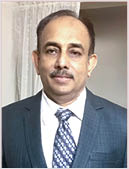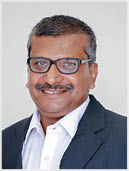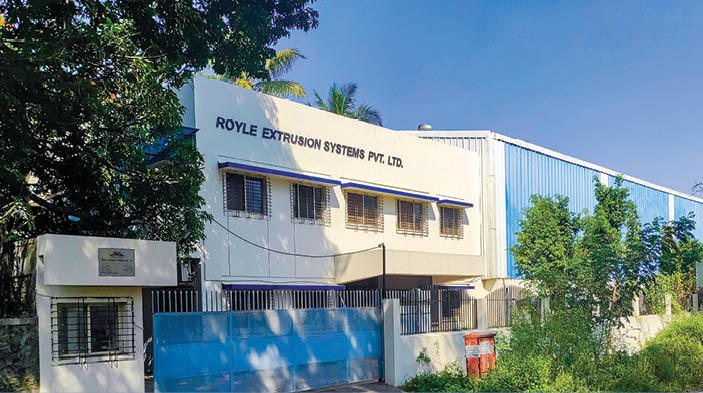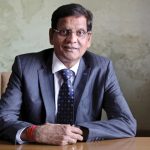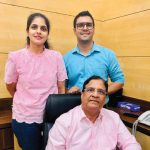US based company, Royle has been present on the global industry map since 1855, pioneering and innovating extrusion technology for the high-speed growth transitions – from the times of Industry 2.0 to Industry 5.0. From Royle’s patented pathbreaking concept of the world’s first screw type extruder, to driving a green world through solar cables’ tandem extrusion lines, the group’s innovation history is a story of technology leadership. After serving the Indian market for 30 years, Royle’s Make in India decision in 1992, led to the formation of Royle Extrusion Systems Private Limited at Pune, fueling the growth trajectory and high demand of the Indian wire and cable industry. In a recent conversation with Wire & Cable India, Mr. Jack Ramsey, Chairman, Royle Systems Group, USA; Mr. Greg Ramsey, CEO, Royle Systems Group, USA; Mr. Paulson T. Kunjukunju, Managing Director, Royle Extrusion Systems Private Limited; and Mr Reji Koshy Daniel, Executive Director, Royle Extrusion Systems Private Limited, shared insights into Royle’s journey with continuous commitment to delivering high-quality extrusion lines at accessible prices, supporting customers both in India and around the world.
Wire & Cable India: Royle’s 1885 patent of the first screw-type extruder marked an early milestone in industrial manufacturing. How did this technology transform cable production globally and specifically in India’s developing manufacturing sector?
Jack Ramsey: Royle’s patented 1885 screw type extruder marked a pioneering milestone in the history of extrusions and thereby in the wire and cable industry. The extruder line of products was first developed for the rubber industry as the automobile industry grew, and then expanded to serve the wire and cable industry as the demand for electricity and telephones grew. Royle still serves the rubber and wire and cable industries with its primary products.
Decades later in 1958, while the industry transitioned to 3.0, Royle fueled the growth with high-speed extrusion and digitization through another Royle patent -Continuous Catenary Vulcanization (CCV).
Following the innovation trajectory for decades, Royle then took on the challenges of Industry 4.0 revolution, facilitating manufacturing of fiber optic cables. The legacy continued as we added extruders for solar cables, greening the power sector through renewable energy in today’s Industry 5.0 priorities.
The industry at large and the history of extrusions are intertwined with Royle’s patents and technology-edge. Many renowned companies around the world have been using Royle lines, backed by a credible history of extrusion since 1885.
Royle recognized the capabilities of the Indian subcontinent very early. Our earliest extruder was supplied in India in 1962, and it remains traceable and reportedly still in use.
Royle decided to Make in India in 1992, a decision that Royle cherishes with India’s capability and synergy for technology leadership. Since its inception, our Pune facility has supported the growth of Indian industry and demonstrated the country’s ability to serve both domestic and international markets.
WCI: The continuous catenary vulcanization line you patented in 1958 revolutionized cable insulation processes. What specific advantages did this technology introduce, and how have Indian manufacturers leveraged these benefits in their current operations?
Paulson T Kunjukunju: Online curing and better-quality curing can be stated as the significant advantages of the Continuous Vulcanizing (CV) lines. The catenary CV line concept, if contrasted with the existing alternatives, was a breakthrough for energy saving, water saving and other resource saving. CCV’s technological advancement alongside environmental sustainability, serves as an advantage that makes CCV still inspire the extrusion legacy.
Another major advantage of CCV, as it evolved with Royle, is the variety of materials that CCV can extrude for insulations- from all types of rubber, to EPR, silicone, PCP, EVA and others. With steam cure series at one end to XLPE and EPDM series at the other end of the spectrum, cables manufactured on CCVs are indeed a marvel in the industry for their technological edge for power transmission requirements in medium and high voltage cable segments with multiple extruded layers as required for these applications.
Watch: Top Cable Companies in India
WCI: With your Pune manufacturing facility serving as a regional hub, how has Royle helped Indian cable producers modernize their production capabilities? What tangible improvements have your clients achieved?
Greg Ramsey: After three decades of exports to India, Royle realized the growth prospects in India with regard to huge domestic demand. It was in 1992, when Royle decided to Make in India and substitute imports by Indian manufacturing at Pune. We always believed in India’s capability to be a hub for the rest of the world. Our Pune manufacturing facility has been a testament to this since 1992.
As a 100 percent owned subsidiary, US’ Royle Systems Group technology team, with their hands-on experience and legacy of knowledge base, ensures the best of technology for every requirement to the India team. Our global team of experts are closely associated with every design proposal that the Indian industry has been requiring.
This has paved the way for the best technical advice to every modernization drive of the Indian cable industry.
Extrusion is a process that is intriguingly different from other high level engineering processes. Over the years, we have built a high caliber design and application engineering team in Pune, alongside translating our technology expertise to the Indian sub-continent, modernizing the cable industry.
Royle can be trusted for technology appropriations – with right advice for every extrusion requirement. In the drive for perceived safety, often the industry goes to “over-designs”, that Royle’s expertise can save, paving the way for saving energy and other resources.
WCI: India’s wire and cable sector faces intense competition with demands for both quality and cost control. How do you engineer your systems to deliver the performance specifications to Indian manufacturers while maintaining competitive pricing?
Paulson T. Kunjukunju: Often, technology comes with a high price tag. But at Royle, it is our philosophy and legacy to ensure technology at an affordable cost, for that alone can fuel further industry growth in emerging economies.
Our customers benefit from the cost advantage in several ways. By design appropriations, our customers not only save on capex, but also on opex for every meter of extruded cables they make. As we do not overprice our technology, Royle can be considered as a high technology at affordable prices that emerging economies can afford, fueling the modernization of several Indian industry partners.
WCI: Your Drycure CV technology has gained traction in medium and high voltage cable manufacturing. What specific operational or quality advantages does this process offer Indian producers compared to alternative technologies?
Paulson T. Kunjukunju: Drycure CV technology is yet another marvel in our spectrum of products. With the rural electrification progress and industry spread in India, the demand for medium and high voltage transmission cables has increased. Our Drycure CV lines bring to the table a high technology edge with nitrogen gas for pressurization of radiant curing and high speed circulation nitrogen cooling in Drycure / Drycool CVs that produce high performance extra high voltage cables.
Royle remains the only company that manufactures CCVs by precisely bending the catenary pipes to the specific design coordinates of the catenary formulae. This manufacturing capability is superior to other methods that use wedges between pipes to approximate the catenary curve, as this inferior method can cause scuffing of cables during the curing process.
Our Drycure (and Drycool) CV lines are high technology, high performance lines that can handle a variety of XLPE and EPR insulation materials. The technology edge spreads to different aspects. For instance, the scrap during the starting and stopping of the line will be controlled by Royle’s process guidance and Royle’s Autoline system in conjunction with Royle’s time-tested Cure-Cool Simulation software, which is yet another proficiency that our customers can benefit from.
WCI: As manufacturing evolves toward smarter, more sustainable production, how is your R&D strategy positioning Royle to support Indian manufacturers with next-generation materials processing and environmentally conscious manufacturing methods?
Reji Koshy Daniel: Royle has been in the industry for a credible period of 170 years. We have, figuratively, extruded a high-speed transition from Industry 2.0 to Industry 5.0. Our technology experts from Royle Systems Group, US will continue to equip and hand-hold our manufacturing facility and R&D centre in Pune.
Royle has already made its presence felt in design optimizations through technology leadership. This will not only add daily savings at every meter of extrusion (optimizing energy, water and other requirements to run the lines), but also add to the industry’s sustainability requirements of ‘Business Responsibility and Sustainability Reporting’, as mandated for top 1000 listed companies by Indian Government, with a farsighted vision for planet sustainability. In their BRSR Principle 6 declarations, our customers will have less carbon emission to report to, so less consumption of natural resources.
Royle has seen and addressed the challenges of insulation and sheathing materials in its journey. At Royle, we have addressed the extruder designs required to process all materials- thermoplastic materials – PE, PVC, PP, Nylon, FEP, etc.; all types of thermosetting materials – EPR, EPDM, CSP, PCP, silicone; and now HFFR, XLPE, XLPO etc.
Royle will stay committed to the next generation requirements of quality, productivity, cost and sustainability as we always have been.
WCI: Several major cable manufacturers in India utilize Royle equipment in their production lines. Can you highlight specific instances where your technology has delivered measurable improvements in either production metrics or final product quality?
Paulson T. Kunjukunju: With our legacy of extruder supplies in India since the 1960s, the majority of leading market players use our extruders. Some are running for decades as a testament to the quality, reliability and farsightedness of Royle technology. Several customer stories can be quoted highlighting the Royle signature in their business for opex control, production speed and sustainability yardsticks- like the carbon savings through the power savings etc.
CASE STUDY
Over 4 decades ago, Royle Systems Group, US supplied a line to a customer in North India. The line with well-engineered design, was a symbol of Royle’s commitment to quality and innovation. However, due to unforeseen circumstances, the plant was closed and the line was idle for 4 decades, which posed a risk to the line. In a bold move, reputed cable manufacturing company purchased the line. Royle Extrusion Systems Private Limited, India undertook the complex task of recommissioning the extrusion line. Leveraging original design integrity and integrating modern technology updates, Royle Extrusion Systems successfully brought the line back into full operation in 2022. The industry has seen ups and downs with new players entering. Yet, Royle’s technology edge leads without overpricing it.





